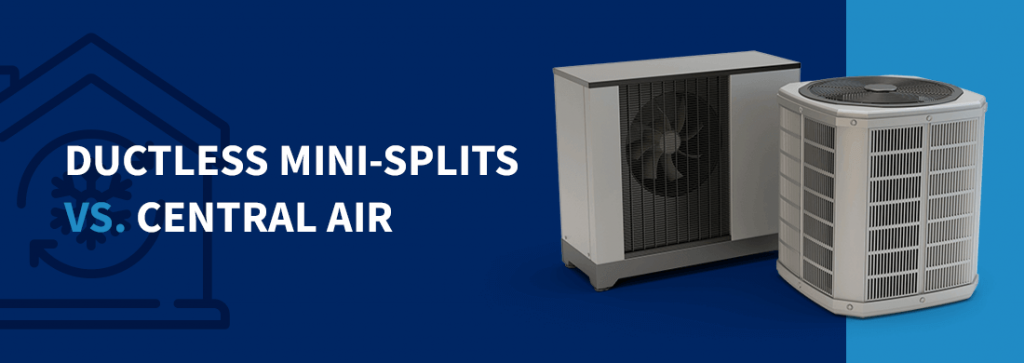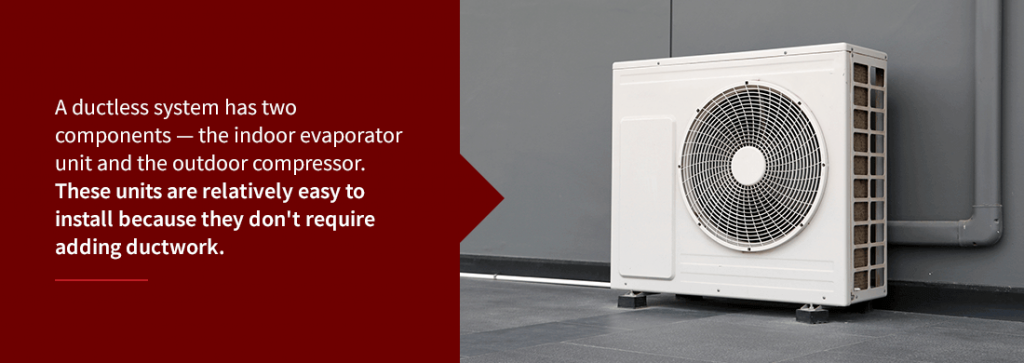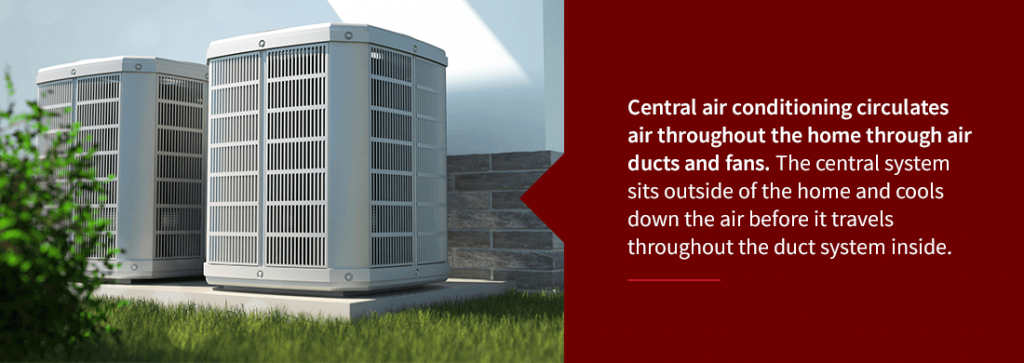Ductless Mini-Splits vs. Central Air
Mar 9, 2021

Homeowners have many options when it comes to their HVAC systems. A traditional choice has been central air systems that include ductwork in the home. But if you’re looking into heating and cooling options for your house, you may wonder if you have other options available.
Ductless mini-splits are rising in popularity. Mini-splits are cooling and heating systems that work efficiently at regulating the temperature in your home. These systems work like conventional air duct systems, but each room in your home would have its own mounted unit. To decide which is right for your house, consult the guide below and learn the differences between ductless mini-splits versus central air.

What Is a Ductless Mini-Split?
A ductless system has two components — the indoor evaporator unit and the outdoor compressor. These units are relatively easy to install because they don’t require adding ductwork. Ductless mini-splits are common add-ons for small homes and apartments, and they come in single-zone and multi-zone systems.
Both ductless and central systems accomplish the task of cooling and heating your home, but which is better, central air or ductless? Homeowners have their own reasons for why they would choose one over the other. To help you decide, first consider the pros and cons of mini-splits.
Ductless Mini-Split Pros
Have you thought about going ductless? Mini-split heating and cooling systems are a great option for many homeowners, thanks to their benefits. Learn about the pros of mini-splits and see if this solution is right for your home:
- Saving energy: Ductless mini-split systems offer great energy efficiency in your home. Because each room has its own unit and no ductwork, each one can manage the temperature of the room while using the smallest amount of energy. Multi-zone households have the advantage of saving more energy because they control when the units are on or off. If a homeowner doesn’t use a room in their house often, they can turn that unit off. Mini-splits can save up to 30% of energy use compared to traditional HVAC systems.
- Ease of installation: Ductless systems are much easier to install. Since you won’t need ductwork throughout the house, it only requires someone to drill a small hole into the wall. From there, the installer will connect the indoor and outdoor units. Another factor to consider is the installation cost of mini-splits versus central air. Installation for ductless systems is more budget-friendly than central air. Since it’s easier to install, it’s a cheaper option for the homeowner.
- Indoor unit options: Mini-split systems have a variety of options for indoor units. Homeowners can choose from wall-mounted, floor-mounted, ceiling cassette and concealed duct mini-splits. Choose the unit that makes the most sense for your home and even mix-and-match indoor units in different rooms.
- Temperature control by room: Since you can have units in each room of your home, the temperature can be different for each area. The indoor units work individually, so if you want your bedroom to be colder than your living room, you have the option to set different temperatures. Everyone in your household can then have custom comfort in their own rooms.
- Ease of maintenance: Ductless mini-splits are smaller and more compact than central air systems. Their size and amount of parts make the systems easier to maintain over their lifetime.
- Compact design: Mini-splits are great for homes that don’t have the room to install ductwork. They are compact and great for places without a large attic or crawl space to install air ducts.
Ductless Mini-Split Cons
Depending on your home and your situation, you may notice potential cons of mini-splits. Knowing the possible drawbacks of mini-split systems helps you make the right decision for your home, so consider these cons that some homeowners experience:
- Aesthetics: Mini-split units can stand out in rooms. The indoor units are often white, which is a versatile color, but the units may be hard to blend with your decor. Since there are a variety of indoor unit types, you can see which ones match your decor the best.
- Upfront cost: The installation cost is cheaper than central air units, but the upfront cost for a mini-split system is higher. They can typically cost around 30% more than central air systems. Although ductless units can have an initially higher price, that’s not including the ductwork you need for central air systems.
- More maintenance: Although maintenance is typically easy, you have to complete it more often with mini-splits. You’ll have to wash the filters every month because the fans in the systems don’t work as efficiently with a lot of debris.

What Is Central Air?
Central air conditioning circulates air throughout the home through air ducts and fans. The central system sits outside of the home and cools down the air before it travels throughout the duct system inside.
Central AC systems also dehumidify the air they bring in to circulate throughout the home. If you live in a humid climate, it might be more challenging for the system to remove moisture from the air coming in. Installing a dehumidifier in your central air unit can help with energy usage because your system is not working harder. Whether you deal with dry or humid air outside, considering the pros and cons of a central air system can help you see if it’s right for you.
Central Air Pros
Many properties have central air systems, and they do a great job at controlling the temperature. Here are some reasons a homeowner would choose a traditional HVAC system versus a mini-split:
- Constant temperature: No matter the time of year, your entire home will be at a constant temperature you set. Walk comfortably throughout your house whether it’s a hot summer day or cold winter evening.
- Air quality: Air filters on duct systems can improve the air quality in your home. As long as you change the filters when you need to, they can help reduce allergens.
Central Air Cons
Homeowners are finding reasons to ditch central air systems and install ductless mini-splits instead. Understand the potential cons of central air systems to see if they are the right option for your home:
- Maintenance: Performing maintenance on the ductwork can be challenging. If you don’t clean your system properly, you can have dirt and bacteria buildup in the air ducts.
- Less energy efficiency: You may not save as much energy with central air systems as you can with mini-splits. Even if you close a vent in one of the rooms, your main unit is still working at its full capacity. Your utility bill will be the same even if you aren’t controlling the temperature throughout your house.
- Ductwork installation: Installing ductwork is a time-consuming job. The need for ductwork also means central air may not be an option for small homes or buildings without the space for the addition.

Are Mini-Splits Better Than Central Air?
If you want to replace your current HVAC system or need to install one in a new home, it can be challenging to decide what system is the best. The choice comes down to efficiency and personal preference. If you need help deciding which type of system to choose, contact Home Climates.
Our team at Home Climates can install ductless mini-split systems or central air in your home and explain the benefits the system will provide. You can also schedule maintenance online or call us for more information on HVAC systems and other services we offer.
